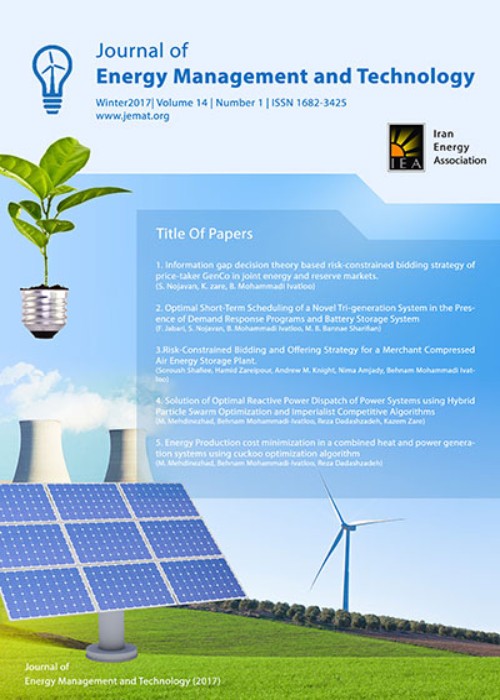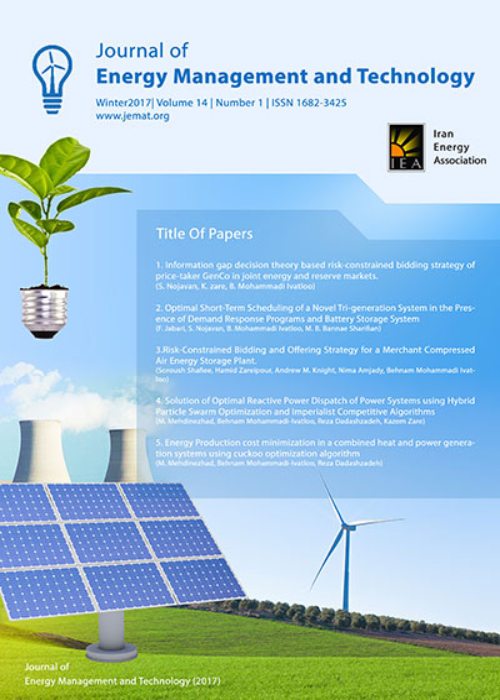فهرست مطالب

Journal of Energy Management and Technology
Volume:8 Issue: 1, Winter 2024
- تاریخ انتشار: 1402/11/25
- تعداد عناوین: 7
-
-
Pages 1-8
In this research, we reviewed the types of geothermal and oil wells as well as their drilling methods. The existing research background has yielded positive results toward increasing sustainability in line with use of abandoned oil wells to utilize geothermal energy. Also, with an emphasis on Iran’s fourth and fifth development plans for sustainability and stressing this issue in the oil industry, we conducted the “SWOT” analysis in this regard. This analysis clarifies four categories of Strengths, Weaknesses, Opportunities, and Threats, also includes a variety of strategies that can be applied in Iran’s oil industry by means of these categories, including the SO strategy, whereby the increase in the use of new energy resources as renewables will lead to increases the positive social attention towards Iran’s oil industry. Also, we conducted the WO strategy in which, investing in research and development can optimize the conversion of abandoned oil wells for geothermal energy production, reducing the high conversion costs and increasing the potential capacity of geothermal energy production. In addition, ST strategy can be functional where increasing attractivity of the oil industry due to sustainable development among other countries can attract foreign capital. Finally, theWTstrategy that a small number of companies that can be linked to cooperate with each other can reduce the risk of the threat of disagreement between managers and organization heads.
Keywords: Geothermal energy, Iran’s oil industry, SWOT analysis, sustainability -
Pages 9-22
In some configurations, microgrid is connected to an AC grid via voltage source converters (VSCs), supplying local non-linear loads (NLLs) of the microgrid connected to the output of the VSC. In such condition, the produced current distortions of the NLLs may flow through the AC grid due to low impedance. Hence, the microgrid should compensate the current distortions, which have been generated by the NLLs. On the other hand, when the AC grid has voltage harmonics, they amplify the produced distortions of the NLLs. To harness these distortions, this paper proposes a new multifunctional control method of the grid connecting microgrid VSC, which can decompose the current distortions into two components originated by the NLLs, and other one by the AC grid voltage harmonics. Then, VSC-based grid-connected microgrid can operate in two compensation modes. The first operation mode includes the compensation of distortions only with considering NLLs contribution. While in the second mode, VSC tries to compensate the distortions with considering contributions of both NLLs and AC grid voltage harmonics. In this mode, the proposed method is able to limit the total harmonic distortion level of AC grid side current in the standard limitation (less than 5%). The effectiveness of the proposed control method is studied using the simulations and experiments.
Keywords: Microgrid, Distortions Compensation, Power Quality, Voltage Source Converter, Multifunctional Control Method -
Pages 23-34
Limitations of traditional power sources and the rising need for renewable energy sources have encouraged researchers and manufacturers to enhance the effectiveness of power converters. Recently, numerous high gain topologies have been extensively designed to solve the main issues of the earlier DC-DC boost converters. In this study, a voltage-lift technique is applied to develop a modified high efficiency, high step-up DC-DC converter derived from a typical Cuk converter. The suggested transformer-less circuit also has the benefits of comprising few components and low-cost implementation compared to similar existing converters. Also, the proposed topology effectively boosts voltage gain by including an additional capacitor and a diode. The operational principle and steady-state analysis of the suggested converter in CCM and DCM are discussed in detail. The capabilities of the recommended topology are then demonstrated by mathematical analysis and comparison with previous similar configurations. Furthermore, the parasitic components are considered in the circuit for precisely computing the voltage gain and efficiency. Finally, experimental test results with nearly 210W output power indicate that the proposed converter can be appropriately employed.
Keywords: Transformer-Less Converter, DC-DC Converter, High Step-Up Converter, Voltage-Lift Circuit, Cuk Converter -
Pages 35-51
The optimum use of energy carriers is one of the important factors affecting the sustainable growth and development of countries. Therefore, monitoring energy consumption is of considerable importance. Energy monitoring with Statistical Process Control (SPC) methods provides a breakdown of energy usage and makes it easier to perceive trends to reduce consumption. A review of the literature shows that previous research has addressed detecting change’s time in consumption. Developing these methods in spatial and temporal aspects of changes in energy consumption, which means detecting the time and location of changes simultaneously, would be able to provide more accurate diagnostic information. In this paper, a novel spatiotemporal framework based on the extension of the generalized likelihood ratio (GLR) and T2 control charts are used for monitoring the electricity consumption of eight-time series related to eight western cities in Mazandaran province, North of Iran, from March 21, 2019, to August 21, 2019. Due to the presence of autocorrelation in electricity consumption data, a model-based approach is proposed to reduce the autocorrelation’s effect on chart performance. The performance of the proposed charts in identifying significant deviations in electricity consumption was evaluated, which indicates the greater diagnostic power of the GLR chart in detecting the time and location of changes. Application of the recently-established spatiotemporal surveillance mechanisms for energy consumption monitoring is the main contribution of this study it would enable practitioners to analyze discrepancies of usage patterns better and make policies for continual improvement of the regional management of electricity distribution.
Keywords: Electricity Consumption, Spatiotemporal Monitoring, Statistical Process Control, Residual-based Control Chart, Autocorrelation -
Pages 52-59
There is growing concern about the release of pollutants from the use of fossil fuels. These concerns have led to the increased use of renewable energy sources and green energy carriers such as hydrogen. This paper evaluates a new hydrogen production system using a solar energy source. For this purpose, the concentrated photovoltaic (CPV) system is used for the first time as the driver of the proposed hydrogen production system. The first and second laws of thermodynamics and the conservation of mass and energy are used to simulate the system. The results show that the PV production power is 1529.4 kW, the turbine output power is 1015.3 kW, the pump consumption power is 126.5 kW, the hydrogen production is 6 grams per second, the energy efficiency is 8.84% and the exergy efficiency is 36.77%. On the other hand, the parametric analysis shows that increasing the nominal efficiency of the PV panel increases the PV power generation, in addition, increasing the ambient temperature decreases the PV power generation. Also, increasing the fluid quality at the evaporator outlet increases the energy efficiency and exergy.
Keywords: Electricity Consumption, Spatiotemporal Monitoring, Statistical Process Control, Residual-based Control Chart, Autocorrelation -
Pages 60-67
Energy hubs (EHs) by considering the interaction between various energy careers are known as promising tools to increase the efficiency of energy networks and pave the way for making the most of resources’ advantages. In addition, EHs due to their ability for converting different types of energies provide the appropriate conditions for increasing green energies such as renewable energy resources and electric vehicles which propels energy networks towards net-zero networks. However, combining a wide range of resources in addition to increasing the complexity of the optimization problem raises the need to model different objectives in the formulation. In this regard, in this paper, a multi-objective mixed integer linear programming is proposed for optimal management of an EH. Three goals are taken into account in this study: minimizing total operation cost, minimizing the emission of fossil-fueled based units, and minimizing interruption in demand. The augmented ɛ-constraint method is utilized to solve the multi-objective problem.
Keywords: Energy hub, Multi-objective, Hydrogen storage, renewable energy sources, Combined heat, power unit -
Pages 68-77
Among different renewable resources technologies associated with solar energies, photovoltaic (PV) systems have grown significantly. The produced power of a PV system is proportional to the solar radiation and so due to the variation in the solar radiation during the day and a year, the generated power of the PV farms changes too. Due to the rotational motion of the earth around itself during a day and also the transitional motion of the earth around the sun during the year, the amount and angle of sunlight on PV panels’ surface change. For enhanced amount of solar radiation on PV panels, the solar tracker can be used to place the solar panels perpendicular to the sun’s rays. Two kinds of solar tracker systems including single-axis and double-axis trackers can be used in PV farms. In this paper impact of solar trackers on PV farms’ reliability is evaluated. For this purpose, a multi-state reliability model is constructed for PV farms where failure of composed elements and change in solar radiation intensity are considered. For determining the optimal states number and associated probabilities of this model, the XB index and fuzzy c-means clustering method are implemented. The suggested reliability model is applied for the adequacy assessment of power networks containing large-capacity PV farms. Besides, the impact of solar trackers on reliability indices of power networks integrated with PV farms is investigated.
Keywords: Photovoltaic farm, Solar radiation, Reliability, Fuzzy c-means clustering, XB index


